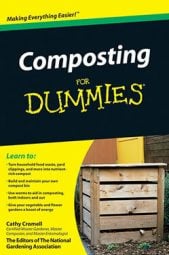This easy recipe for a freestanding pile works well for just about anyone. You can also follow these instructions but layer the material in a bin of some sort, if you choose to use a compost container. As you gain experience, these steps serve as a starting point for developing your own favorite composting formula:
Spread 4 inches (10 centimeters) of chunkier, dry, brown materials — such as branch trimmings, corn stalks, or straw — as the base to promote good aeration.
If unavailable, use other browns you have on hand and insert an airflow tube.
Sprinkle all materials with water as you build. Organic matter should have the moisture of a wrung-out sponge.
Layer 4 to 5 inches (10 to 13 centimeters) of additional brown materials, such as dry leaves or shredded paper.
Moisten all materials as you work.
Toss in a few handfuls (or shovelfuls) of your native soil between layers as you build.
It's loaded with microorganisms ready to work.
Layer 2 to 3 inches (5 to 8 centimeters) of green materials — such as grass clippings, kitchen scraps, spent garden annuals, or manure — on top of the browns.
Moisten all materials as you work.
Continue alternating and moistening layers of browns and greens, ending with a layer of browns on top to insulate the pile.
Your final pile should be a minimum of 3 cubic feet (1 cubic yard or 1 cubic meter), up to a maximum of 5 cubic feet (1.5 cubic meters).
Optional: Cover the pile with a tarp.
In rainy locations, the tarp prevents the pile from getting too soggy. In arid regions, it prevents material from drying out.
If you do nothing further at this point, you'll have some harvestable compost from the bottom and center of the pile in three to six months. Variations occur based on how small the pieces of organic matter are at the start and how long the pile retains moisture and aeration in your region.
Toss any chunks of organic material that don't decompose fully the first time around (especially from the outside edges of the pile) into the next pile you construct.
If you turn and remoisten basic compost once or twice, you'll have more compost sooner.

